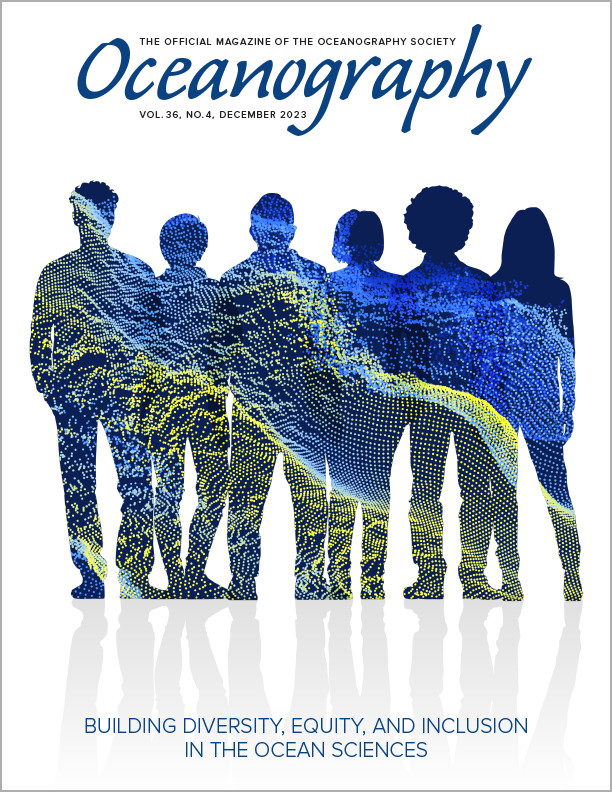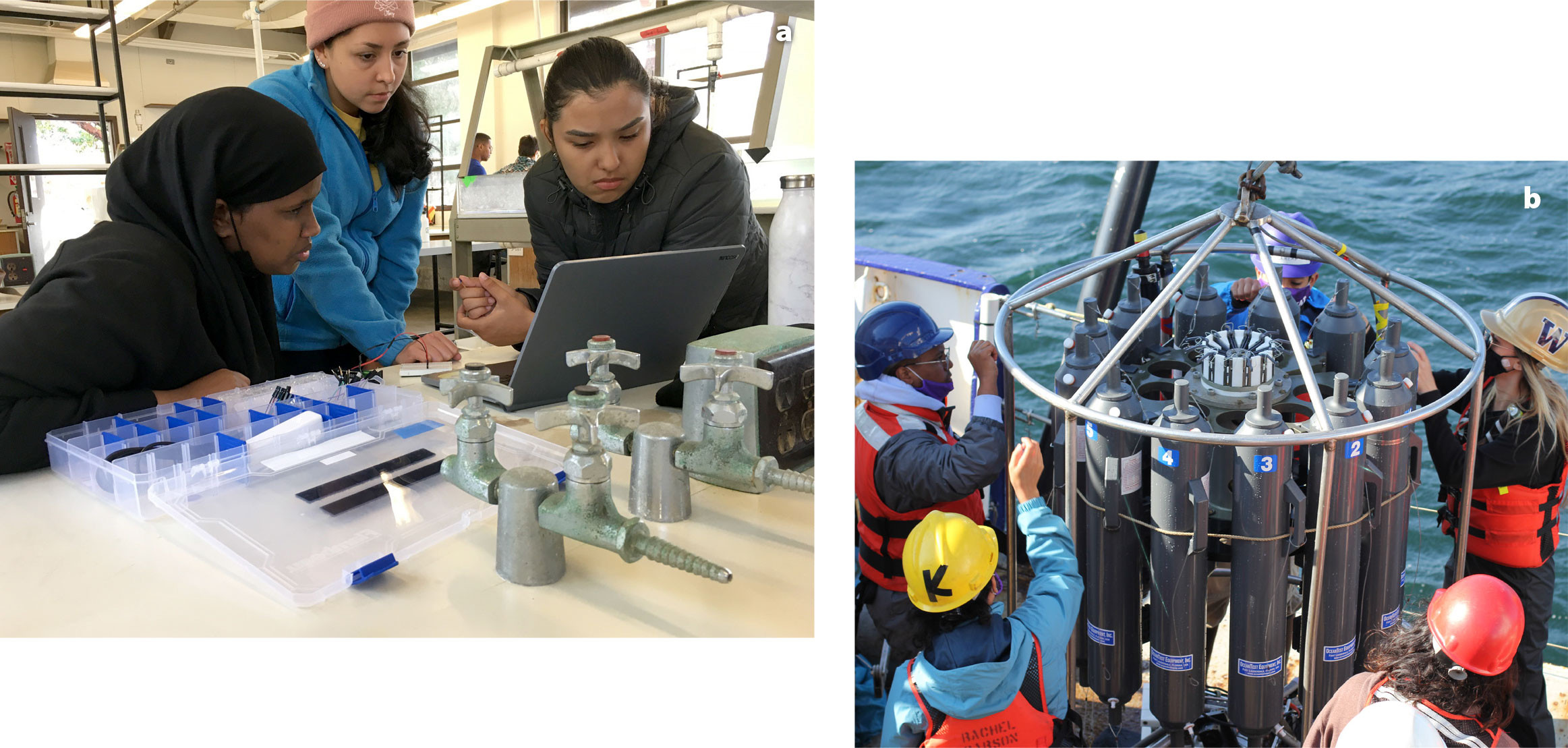Full Text
Introduction
Students enrolling in community colleges often represent more diverse populations, come from different socioeconomic backgrounds, and have frequently followed nontraditional pathways into higher education as compared to first-year students at four-year institutions. Community colleges (CC) are also an important route toward STEM careers for students of high potential from marginalized communities (Mooney and Foley, 2011). Early exposure to geoscience at four-year institutions is an effective means of recruitment to these sciences (Stokes et al., 2015), but CC students rarely have the opportunity to take marine science courses.
To address these issues, we developed GEODUC—Geoscience Education, Oceanographic Discovery, Undergraduate Collaboration—a place-based summer bridge and year-round mentoring program designed to increase CC transfer student interest and retention in the geosciences with funding from National Science Foundation’s Pathways into Geoscience (GEOPAths) program. We hypothesized that (1) if CC students are introduced to the full breadth of STEM majors, including geoscience majors, and are exposed to the connection between geoscience and real-world problem-solving, then recruitment to these majors would increase, and (2) if students were adequately prepared for these majors, then they would be more likely to select these pathways, and be retained in them. Here, we present our preliminary results and lessons learned from the first year of the program at the University of Washington (UW, Seattle).
|
|
Program Description
Our program is divided into three core phases: (1) recruitment, (2) bridge program, and (3) mentoring seminar series.
Recruitment (February to June)
During the six months prior to the program application deadline (July), program leads shared recruitment materials (e.g., a program digital publication and flyers, outreach videos) with individual instructors teaching STEM courses at local CCs and offered virtual and in-person information sessions at UW with both faculty and student ambassadors. Upon admission to UW, central admissions sent all STEM transfer students personalized messages about the GEODUC program, along with application instructions. Students admitted as transfers to UW were selected based on their responses to prompts on environmental issues and their articulation of what they would expect to gain from the program.
Bridge Program (September)
The bridge program is a 10-day immersive experience at Friday Harbor Laboratories (San Juan Island, Washington) before fall quarter begins. This residency program was designed to facilitate collaboration and community among the participants while also building skills in critical thinking, scientific inquiry, and data analysis—the skills necessary to succeed in geoscience majors. The participants were introduced to issues of local importance (e.g., the impact of climate change on marine food webs, salmon and eelgrass habitat) in a sequence of three three-day modules, with the last day of each module reserved for student presentations of their independent research projects. Participants explored the key local issues through experiential work that included hypothesis testing, experimental design, sampling and data collection, data analysis, and communication, with the intent that they gain confidence as geoscience practitioners. Work involved collaborative experiments in intertidal zones and in wet labs, sensor building and deployments, and oceanographic data collection aboard the research vessel Rachel Carson. All expenses were covered for the participants, and they also received stipends.
Mentoring Seminar Series (October to June)
Students subsequently enrolled in a one-hour weekly seminar course during their first years as UW transfer students. All the participants in the summer bridge program, as well as the top 10 applicants whom we could not accommodate at Friday Harbor Laboratories, were invited to join the seminar and received one elective credit each quarter. Seminar enrollment and themes varied each quarter. Fifteen students enrolled in the fall, seven in winter, and eight in spring. Themes included academic success (fall), getting involved in research (winter), and career opportunities (spring). We hosted sessions with scientists and professionals across the geosciences (e.g., academia; tribal, federal, and state agencies; industry; nongovernmental organizations) and at different career stages (e.g., graduate students, entry research scientists, and senior professionals). Presenters were asked to describe their career paths, including both successes and detours along the way. Efforts were made to highlight Black, Indigenous, and People of Color geoscientists. Quarterly field trips were added to the program to provide additional inquiry-based marine science exploration while solidifying connections among participants.
Assessment
The program was assessed using frequent surveys—pre- and post-residency program, daily during the summer bridge program, and weekly during the seminar courses. Assessments were aimed at exploring program impact on students’ confidence in their knowledge and skills, degree of interest in geoscience research and careers, and sense of belonging at UW and in the geosciences. After their first quarter at UW, participant academic performance and attitudes were assessed through interviews that were also used to gather information about how to improve the program.
Results
Recruitment
Recruitment for the first cohort (2022–2023) involved 12 local community colleges. The applicant pool was 37 students. We were 100% successful at recruiting HEG (historically excluded group) participants both for the summer bridge program (80% Latinx, Native American, or Black; 50% first generation; 80% female), and the seminar series (83% Latinx, Native American, or Black; 58% first generation; 92% female). Of the different recruitment strategies, we found that personalized messages to CC instructors teaching STEM courses as well as emails sent directly to transfer students upon admission to UW resulted in the largest numbers of applicants.
GEODUC: Bridge Program and Seminar Series
Living together during the bridge program was crucial in facilitating collaboration, social exchange, and a sense of community that enriched the learning experience and helped prepare students for their academic journeys at UW. Of the 10 applicants who participated in the 10-day field experience, 100% were retained at the university, and all enrolled in STEM majors (eight geoscience majors, and two engineering with declared interest in exploring geoscience principles within their disciplines). Four additional students participated in the seminar series and field trips; three of these students enrolled in geoscience majors. The summer bridge program was effective at enhancing hands-on, independent research skills (mentioned by 90% of participants in interviews) and confidence in conducting research experiments (using a Likert scale where 5 is very confident and 1 is not at all confident, bridge participants reported a mean of 4.3 and non-bridge a mean of 2.6). Our preliminary results indicate that regular, low stakes interaction with professionals through the seminar series was very effective at fostering a sense of community and belonging among transfer students, creating a supportive environment where they learned from one another, and building lasting connections.
Beyond the GEODUC Program: Early Successes
Nine GEODUC participants (64%) received competitive fellowships (NOAA Marine Mammal Laboratory Fellowships) in their first year at university. GEODUC participants gave 13 individual scientific presentations at three separate professional meetings (e.g., National Diversity in STEM Conference, UW Undergraduate Research Symposium).
Lessons Learned
The GEODUC program serves as a model for supporting community college transfer students to four-year research institutions through the early introduction of locally based research in geoscience. We were successful in recruiting 100% HEG participants. Direct emails to transfer students from central admissions resulted in the largest number of applicants with the lowest investment of time and resources by program personnel. Recruitment to the geosciences was encouraging: 8 of the 14 GEODUC participants (bridge plus seminar) are pursuing geoscience majors. Subsequent to the program, two enrolled in double geoscience majors and one student changed to a geoscience major. The bridge program was effective at increasing research skills and confidence, while the seminar series created a lasting support network. The bridge program was scheduled to run again in September 2023 with 16 participants, and enrollment was to be increased in the seminar series. As suggested by bridge participants, going forward, we will spend more time exploring San Juan Island marine habitats and will meet with members of the community to develop a better understanding of the threats to the island’s marine resources. We found that the seminar is the most exportable, cost-effective, and accessible component of the program to support transfer students throughout the academic year.


